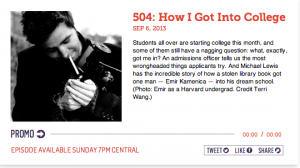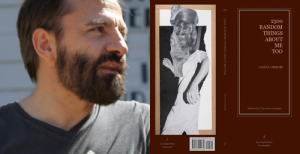September 12th, 2013 · Comments Off on Damasio’s Terms
Antonio Damasio’s theories of consciousness and the self are complicated and can get bewildering on a first reading. This is partly because he builds the theory through the explanation of relationships among a pretty large number of parts. The good news is that he’s careful to define his key terms–which give names to these various parts. A good way to get a handle on Damasio is to keep track of his key terms as you read and to revisit them. First, be sure that you understand his definition of each term. Then, do your best to understand the relationships among the terms. If you understand these relationships, you’ll understand the nuances of the theories he proposes.
Here’s a list of terms to look out for:
- organism, object, and image
- core consciousness and extended consciousness
- primordial self, prot0 self, core self, autobiographical self
- self-as-subject and self-as-object
- qualia, emotion, and feeling
- image, neural pattern, neural representation, maps
- internal milieu and homeostasis
- body loop and “as if body loop”
You’ll find these terms scattered throughout the two texts we’re reading. Just look out for them at first and mark them when you come across them. Revisit them later and see if you think you’ve understood his point with regard to each. (Some of the terms will be familiar from Hustvedt and Eakin.)
We’ll talk about all this in class, but your reading will be easier and more productive if you focus on the terms from the outset.
Tags: Uncategorized
September 12th, 2013 · Comments Off on Natalie Sutherland on “The Fiction in Autobiography”
Natalie Sutherland has published an interesting account of the relations between autobiography and fiction in the online magazine Perilous Adventures, entitled “The Fiction in Autobiography: Fantasy, Narrative and the Discovery of Truth.” A lot of her discussion relates to ideas we talked about in class tonight. A colleague, Carrie Hintz, who’s teaching an “Approaches to Life Writing” course in the MALS program, sent me the link to the article. You might find the material her students are posting on their blog interesting–and relevant with regard to our discussions. I’ve linked to it above. I’ll add it to our list of links too.
In the meantime, here’s an excerpt from Sutherland’s essay:
We concluded above that there is a difference between narrative as it is “lived” or experienced in life and narrative as it appears in autobiography. Mustn’t there then also be a difference in the life and in its narrated counterpart? This leads us to the notion that autobiography is not be a simple recalling of the past – to engage in such an act would elude the entire concept and act of narrative, both in life and in writing, since narrative involves not merely thumbing inattentively through life’s experiences, but sequentially and meaningfully relating the ‘parts to the whole.’
Tags: Uncategorized
September 9th, 2013 · Comments Off on For Wednesday’s Class
For Wednesday’s class, choose a moment in Siri Hustvedt’s book in which she uses one of Gordon Harvey’s “Elements” in an interesting ways. (If you weren’t in class for our first meeting, see the Documents page on this blog.) You might choose this moment because Hustvedt uses Harvey’s element in a way you’d like to emulate; or because she uses it in an usual way; or simply because her use of it confuses you or raises questions you’re not sure how to answer. You may have another reason altogether, or a combination of reasons. It’s up to you. We’ll spend the first part of class comparing the moments you’ve chosen, so have them at the ready.
I’ll give you an example, with regard to Hustvedt’s use of both sources and stance. In the following passage, Hustvedt has the chutzpah to rewrite Freud:
In The Ego and the Id (1923) Freud writes, “The question ‘How does a thing become conscious?’ would thus more advantageously be stated, ‘How does a thing become pre-conscious [available to consciousness]?’ And the answer would be ‘through becoming connected to the word presentations corresponding to it.’ ” Further, he says, these words are “residues of memory.” He does not deny that visual imagery is part of the remembered mental world, but he argues that it has another character, that being conscious of an optical memory is more concrete and that “the relations between the various elements of the subject matter, which especially characterizes thought, cannot be given visual expression (59; ebook 46/159)
Hustvedt’s revision of Freud is characteristic of her writing–and her stance in particular. It’s clear that she admires Freud, and often displays real affection and respect for his work. But she’s not afraid to say he’s gotten this wrong, or at least not quite right. The difference between “conscious” and “preconscious” is important to Hustvedt because it indicates something fundamental about both mind and self: we don’t control which thoughts or feelings become conscious. Hustvedt follows Freud in seeking a logic for how and why particular thoughts and feelings become “available to consciousness,” but she stresses the fact that their availability doesn’t mean they ever will become conscious. They may influence us without our ever knowing it. Her quest to understand “the shaking woman” is driven at least partly by a desire to gain a better sense of how her own preconscious feelings may be influencing the behavior of her body. So, basically, Hustvedt uses a source her in a way that seems characteristic of her stance toward the history of ideas. Let’s be respectful, she seems to be saying, but not precious. She implies that she, like Freud (or anybody else) is likely to get some things wrong, and that we shouldn’t worry too much about that, because genuine contributions to intellectual debates require the audacity to make claims even when you know you’re likely to be wrong at least as often as you may be right.
In another passage, Hustvedt offers an extremely articulate explanation of her method:
Who are we, anyway? What do I actually know about myself? My symptom has taken me from the Greeks to the present day, in and out of theories and thoughts that are built on various ways of seeing the world. What is body and what is mind? Is each of us a singular being or a plural one? How do we remember things and how do we forget them? Tracking my pathology turns out to be an adventure in the history of experience and perception. How do we read a symptom or an illness? How do we frame what we observe? What is inside the frame and what falls outside it? Janet’s patients didn’t have brain scans, but Neil did. Neil’s scan does not explain his dissociated orthographic memory. Automatic writing once had a place in medical theory. Now it is an outcast, a curiosity that stuns researchers. Why? (69; ebook 53/159)
Notice that she characterizes her method as “an adventure in the history of experience and perception.” Adventure requires daring–and fun. Hustvedt begins with some questions: “Who are we, anyway? What do I actually know about myself?” To find answers, she has to read voraciously in a variety of fields and synthesize what she reads. Then she has to find ways to articulate what she has learned and synthesized in ways that will appeal to an audience.
Every writer has to do this, but not every writer is quite so articulate about her processes and methods. One goal for this course is for us all to become more aware of the processes and methods we develop in order to find answers to questions we care about as passionately as Hustvedt cares about hers. It doesn’t hurt to have some fun in the process.
Tags: Uncategorized
September 7th, 2013 · Comments Off on On This American Life

This week’s episode of This American Life (entitled “How I Got Into College”) features a story about economist Emir Kamenica–which resonates pretty strongly with our reading for this week. Kamenica tells Ira Glass a story about a teacher who changed his life as a child. Glass hires an investigator to find this teacher, and she tells her version of the story. Then the staff of the show does some fact-checking. I don’t want to give away any details, but it’s pretty interesting to hear what happens when Glass confronts Kamenica with alternate versions of the story of his own life. The episode is airing on various NPR affiliates this weekend. It will be available online after 7 pm on Sunday.
Tags: Uncategorized
August 29th, 2013 · Comments Off on Wayne Koestenbaum Reviews Matias Viegener’s 2500 Random Things about Me Too
 We’ll read Matias Viegener’s 2500 Things about Me Too later this semester, so I thought I’d share this review, written by the GC’s Wayne Koestenbaum for the Los Angeles Review of Books.
We’ll read Matias Viegener’s 2500 Things about Me Too later this semester, so I thought I’d share this review, written by the GC’s Wayne Koestenbaum for the Los Angeles Review of Books.
Tags: Uncategorized
August 29th, 2013 · Comments Off on Reading Questions for The Shaking Woman
For those of you posting responses to Siri Hustvedt’s The Shaking Woman, you may want to focus on one (or more) of the following questions. This is by no means a requirement, though. If you want to focus on other questions, ideas, or details, go ahead and do that.
1. Hustvedt refers to her book as an “essay,” rather than a “memoir.” Why do you think she does so? How would you classify it? Why? How does your understanding of the genre shape your reading of the book?
2. In order to tell her own story, Hustvedt explores neuroscience, psychoanalysis, history, medicine, feminism, philosophy, memory, and physiology. Why does she need such a broad range of sources in order to understand the relationship between her physical symptoms and her sense of self? Choose one or two of these sources and discuss some ways they help her understand her experience.
3. Does Hustvedt’s book prompt you to reconsider any of your own assumptions about selfhood?
4. What are the similarities and differences in the ways that Hustvedt and Eakin incorporate neuoroscience in their writing. What are their aims in doing so? What are their methods? How productive are the results?
Tags: Uncategorized
July 25th, 2013 · Comments Off on Welcome to MALS 70000: Introduction to Liberal Studies–Inventing the Self
This blog will be the online home for our course. You will find our course readings, calendar, and requirements here. You will post bi-weekly responses to our reading and engage in online discussion and debate about these readings. You will also find links to online lectures related to topics we are reading about. These lectures will become the basis of our research projects later in the semester.
I’m looking forward to meeting–and working with–you all.
Tags: Uncategorized




